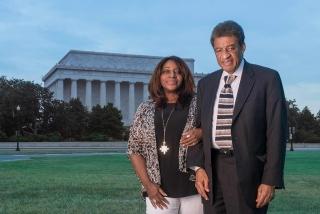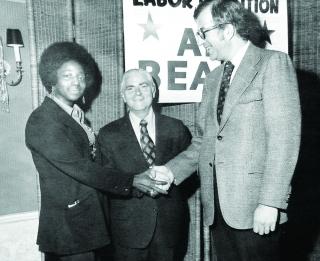“My mother was a trade unionist, and she took me on picket lines,” says Velma Hill. “As a kid, I was taught you’ve got to fight for what you believe in.”
Decades later, Hill is still fighting.
And as paraprofessionals celebrate 50 years in the UFT, members can thank Hill, the chapter’s founder and first chair, for leading the charge to uplift paras and their communities by transforming their job into a secure union career.
Shelvy Young-Abrams, the current chapter chair, recalls joining the DOE as a “family worker” before there were paras and getting involved in the organizing effort. As a single mom raising two children on welfare, she was close to giving up. “Velma gave me the tools and the knowledge to keep fighting on,” Young-Abrams says.
She also credits Hill with getting her a part-time job at the UFT that furthered her interest in the union movement. “It’s because of Velma that I am where I am today,” Young-Abrams says.
In 1960, Velma Murphy, the 21-year-old president of Chicago’s South Side NAACP Youth Council, and activist Norman Hill led an integrated group of young people in a protest at Lake Michigan’s Rainbow Beach, which was racially segregated by practice, not law.
It was, she says, “the start of a civil rights career for me.”
“As we walked onto the beach,” she recalls, “I was a little nervous, a little scared, and I remember thinking, ‘Velma, you’re the leader here and you’ve got to be courageous.’”
Nearly 60 years later, an emotional Hill talked about how a “menacing” mob attacked the protesters, leaving her bloodied but not bowed.
It was the first time Hill would lead, but not the last time courage would be her hallmark.
Velma married Norman Hill, and they came to New York in 1961. She earned a graduate degree from Harvard and then returned to the city. She became a field secretary with the Congress of Racial Equality (CORE), meeting civil rights activists including Bayard Rustin, A. Philip Randolph, Malcolm X and Albert Shanker, who would help her organize paraprofessionals.
The Hills left CORE in 1968, but through their work on the 1963 March on Washington, they had met trade unionists who “convinced us we had to talk about both race and economics,” says Hill. Her husband helped organize the A. Philip Randolph Institute of black trade unionists while she began her work with paraprofessionals.
At the time, she said, only about 7 percent of teachers in the system were minorities. She believed by organizing paras, “we could help integrate the teaching field with people from the community who had a real interest in the schools.”
Hill approached Shanker, then the UFT president. If she wanted to organize paras, he said, she had to become one. Hill became a para at PS 122 in Manhattan in 1968 and remained one for her entire city public school career.
It was right after the Ocean Hill-Brownsville conflict, which culminated in two teacher strikes pitting the union and mostly white teachers against the minority communities they served.
The paras leading the organizing effort faced racism and anti-union bigotry.
“One community school district didn’t want us to come to the community board meeting,” Hill recalls. “Someone had a baseball bat, and they were saying nasty things about me and the union. They would tell paras who went to the union, ‘Teachers are not going to respect you.’”
But the organizers earned the support of teachers by hard work and diligence. “We realized we had to educate both teachers and paras,” Hill says.
“Al Shanker and I went to every borough to talk to teachers about why it was important to organize paras,” Hill says, “and I was in charge of telling paras why we should be in the same union and have solidarity with teachers.”
They formed committees, held seminars and emphasized the need for community support. They pitched stories to newspapers about paras and teachers working together.
When the first contract for paraprofessionals was signed in 1970, paras gained the respect and recognition they deserved, a salary more than double what they had been earning and the beginnings of a career ladder that today is unequaled.
Hill recalls that some paras were skeptical of what was, to them, an unknown — the benefits of joining together in a workplace organization. “I remember telling them, ‘You’re not black, you’re not white, you’re not Hispanic, you’re a paraprofessional! You belong to a union, and we’ve got to be together.’”
During contract negotiations, Hill says, paras were nervous that union membership meant the possibility of strikes. Upset and tired, Hill sought solace from her mentor, Randolph.
“He told me a story that still guides me,” Hill says. “A stone cutter had to break a rock. He hit it 100 times, and it would not split. He got so tired. But at the 101st blow, the stone split apart. And Randolph said, ‘Velma, it was not the last blow that did it, it was all that went before.’”
That was true with the paras, Hill says. “It’s going to be what we do day by day, week by week, and that’s why Norman and I keep working.”
For all of their 58 years together, Velma and Norman Hill have been fighting for civil rights and workers’ rights.
“My husband and I decided if we couldn’t change the world, we would change a little corner of it,” Hill declares.
The corner Velma chose belongs to paras.

